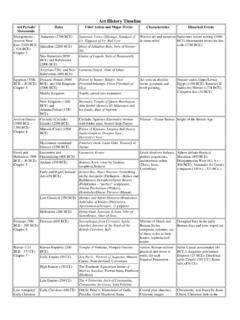Transcription of Athens & Sparta
1 1 Athens & Sparta : Democracy vs. Dictatorship Dr. Peter J. Brand During the archaic and classical periods (ca 800-323 BCE), Ancient greece consisted of several hundred poleis1 or city states. Each polis was its own small country. Many of these were no more than small towns or even villages which controlled sometimes very small territories. At the opposite end of this spectrum were the two largest, most powerful and ultimately most influential Greek city states, Athens and Sparta . Politically, they were polar opposites of each other. The city of Athens and its territory of Attica was a cultural and economic powerhouse. Athens was the birthplace of many fundamental aspects of Western civilization, including ethical philosophy and the theater. The Parthenon and its iconic temple to the goddess Athena are the cornerstones of Western architecture. But it is in the political realm that modern civilization owes much to Athens , for it was here that democracy was born.
2 Athens democratic government and open culture stood in stark contrast to the government and society of its chief rival Sparta . Sparta was a warrior society of fierce, often unbeatable soldiers, and only war riors participated in political life. Spartan women had a reputation for being as fierce as their men, quite unlike their reclusive, segregated sisters in other Greek poleis. Sparta was an imperial state which subjugated many of its neighbors in the Peloponnesus and turned their populations into a class of virtual slaves called helots. This serf class outnumbered the Spartans many times over, so to keep the helots under control and suppress rebellions, the Spartans organized their entire society along military lines. The sole purpose of a Spartan man was to be a soldier and the only duty of a Spartan woman was to give birth to many more soldiers. The site of ancient Sparta . Few ancient remains of Sparta exist. 1 Poleis is the plural form.
3 The singular form is polis. 2 Sparta Ancient Sparta lay in the wide, fertile plain of Laconia in the Peloponnesus peninsula of southern greece . The Laconian plain was large and agriculturally rich, and was separated from neighboring regions by tall mountains. In the classical period, Sparta itself was never a large city like Athens . Instead, its urban core consisted of a clump of four villages. The Spartans were warriors, not builders, and had little use for the architectural grandeur, theaters, or high culture of Athens . Unlike most other warrior states, the Spartans were not even interested in military architecture. Instead, Spartan walls were said to consist solely of its young warriors. Map of the Peloponnesus peninsula in southern greece with the locations of Sparta . The Greek historian Thucydides said of Sparta : If Sparta was to be deserted, and nothing left but the temples and ground-plan, distant ages would be very unwilling to believe that the power of the Spartans was at all equal to their fame.
4 Their city is not built continuously, and has no splendid temples or other monuments; it rather resembles a group of villages, like the earliest towns of greece , and would therefore make a poor show. His words were prophetic, for unlike the impressive ruins of Athens or other Greek centers like Delphi and Olympia, few archaeological remains have been discovered at the ancient site of Sparta . The most impressive Spartan ruins date long after the period of Spartan greatness when in later Hellenistic and 3 Roman times a kind of theme park or Spartan Disneyland was built for ancient tourists to visit. Sparta s Neighbors By 750 BCE, the Spartans controlled the entire plain of Laconia. Within this territory, they were a minority, but one that dominated a larger population of non-Spartan peoples. One group of non-Spartans were the Periokoi, or neighbors. The term Periokoi literally means those who are on the fringes. The Periokoi were not Spartan citizens.
5 They were free men, not slaves and they enjoyed a degree of local autonomy in their domestic affairs, but were distinctly inferior to Spartans. Periokoi owed military service to the Spartans, where they served in segregated auxiliary military units. Sparta s neighbors primarily filled the roles of skilled craftsmen and traders, occupations that the Spartan men themselves came to reject in favor of the life of full-time career soldiers. The Helots Despite the inferior social and political status of the Periokoi, they were much better off than another group of non-Spartans called the Helots. Helots were by far the largest class of people living in Spartan territory. Most of the Helots came from the lands of the once free and independent neighboring city-state of Messenia who had been defeated in battle by the Spartans. The Helots became virtual slaves, owned not by individual Spartans but collectively by the Spartan state. The Helots in Laconia and in Messenia worked as peasant serfs who farmed the land for the benefit of their Spartan overlords.
6 Not content with their status, the Messenian Helots would rise up in a series of massive rebellion and force the Spartans to reorganize their entire society along military lines to suppress the Helot population. 4 Messenian Wars By around 730 BCE, Sparta had conquered the neighboring city-state of Messenia in the south-west corner of the Peloponnesus. Messenia ceased to exist as an independent polis for 400 years. Its population was made Helots, a class of serfs/slaves belonging to the Spartan state. The lands of Messenia were divided up among the Spartan population, and each parcel of land came with a population of Helots who now farmed it for the benefit of a Spartan man and his family. Not all Spartans received land only veterans of Messenian wars received this gift, and this became the basis of the Spartan aristocracy. One Greek author described the sad fate of the helots: bitterly oppressed with great burdens like donkeys, they (Helots) must bring to their masters out of grievous necessity, a half of all the fruits of the fields.
7 Another author reported that: They (the Spartans) assign to the Helots every shameful task leading to disgrace. For they ordained that each one of them must wear a dog skin cap and wrap himself in animal skins and receive a certain number of beatings every year regardless of any wrongdoing, so that they would never forget they were slaves. Moreover, if any exceeded the vigor proper to a slave s condition, they made death the penalty. The Helot Dilemma While Helots were forced to work their own ancestral lands and give as much as half its produce to support Spartan citizens, the Messenians and other Helots in Laconia were clearly not happy with their fates. The Spartans lived in constant fear of massive Helot uprisings, and such rebellions happened on several occasions during the next 400 years of Spartan dominance. The Greek historian Thucydides reports that Spartan policy is always mainly governed by the necessity of taking precautions against the helots.
8 Spartan armies rarely traveled far from home for fear of revolts among the Helots. The Spartans had good reason to fear the Helots who outnumbered them. The defeat of a Spartan army triggered a major revolt among the Messenian Helots known as the Second Messenian War. The war was long and tough for Sparta , lasting from 685-668 BCE. Messenian resistance was eventually crushed, but the end result was an even larger population of subject Helots who now outnumbered the Spartans by a factor of seven to one. Spartan Militarism The Second Messenian War frightened the Spartans so much that they reorganized their entire culture and political system along military lines. Henceforth, every Spartan male was to be a lifelong soldier to the exclusion of all other professions. Military training began at the age of seven, and Spartan men remained on active duty until they reached the age of 60 this at a time when the 5average life expectancy was only 35.
9 Spartan men could expect to be soldiers for almost their entire lives and would likely die as soldiers, whether in battle or not. Although Sparta fought many wars with other Greek city-states, the arch-enemies of every Spartan solider were the Helots. Sparta remained permanently at war with the Helots. Each year, this war was formally declared anew. Spartan men stood vigilant against the slightest signs of a Helot uprising. Bronze figurines of Spartan warriors. Spartan Education System Training for a lifelong career as a soldier began very young for Spartan males and their selection, or rejection, for a soldier s life began shortly after their birth. Newborn babies were soon inspected by a group of Spartan elders that examined them for physical fitness. At the first sign physical defects or 6weakness such as a babe that seemed ill, or puny or deformed the infant was cast to its death into a ravine from the top of a nearby mountain.
10 Both boys and girls were subject to this treatment. Males had to be strong soldiers and females had to give birth to many sons. Ultimately, it was the Spartan state that decided if a child was fit to live or die. Boys and girls also shared a form of universal education that was unique in the Greek world, both because it was provided and controlled by the state and because females were also educated. Yet the Spartans cared little if their children could read. The Agoge was a system of physical education for the sole purpose of preparing boys to be soldiers and girls to be baby-factories. For boys, the education system was known as the Agoge or up-bringing system. For the first six years of his life, a Spartan boy lived with his mother. On his seventh birthday he was taken from her and enrolled in the compulsory military education system, the Agoge. He was trained as a soldier until the age of 20, when he entered into active duty in the Army.










